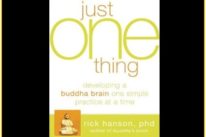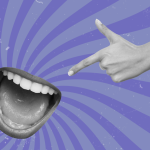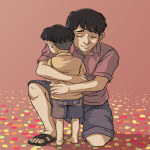
“I do not ask the wounded person how he feels, I myself become the wounded person.” ~Walt Whitman
Empathy is the ability to put yourself in another’s experience and understand with depth the gravity of their situation. In general, I believe the world needs more empathy.
But I’ve learned over the course of my twenty-nine years that sometimes being a highly empathetic person is incredibly painful. And sometimes too much of a good thing is a bad thing.
Hearing stories of the pain that people experience can be extra painful when your mind tries to carry their pain around with you. Empathy is healthy when it’s useful and helps a wounded person feel understood and validated and release their pain. But it’s unhealthy when you carry it with you as if it is your own.
Feeling sorrow for someone who is suffering is part of our humanity and connection to each other. Carrying the sorrow as if it belongs to you ends up feeling traumatizing and can cause you to disconnect from others.
I’ve always struggled with holding on to the pain of others. From the stories of suffering I hear on the news to the people I run across in my everyday life, I’ve found it difficult not to get lost in their pain and end up holding on to it. When that problem hit even closer to home, I reached a breaking point that ended up teaching me how to stop it.
My sister is a nurse who was working on a trauma unit floor the day she was assaulted by a patient. Seeing the bruises covering her face and her eyes swollen shut was a gut wrenching experience. For months after that my mind turned over and over again how she must have felt.
I’d see the surprise and fear on her face in my mind’s eye. I’d feel the terror and the pain. And the overwhelming relief when he was finally off of her. Followed by the sense of humiliation and vulnerability at being alone on the floor.
She was wounded. My overly empathetic brain created me as the second wounded one.
I am a highly sensitive woman who struggles with both ADHD and Anxiety. These three challenges come together into the perfect storm to torture me with too much empathy sometimes.
High sensitivity makes me more attuned to others. ADHD makes it extra difficult to control my runaway thoughts. Anxiety creates a sense of ongoing vulnerability that keeps the wound open. This perfect storm has required a strong internal set of resources to combat it. In the traumatic aftermath of my sister’s assault, I finally found the recipe for that resource.
These three things have helped me reduce the internal wounding of being too empathetic.
Mindful Attention to Words without Pictures
I was on the phone with my mom as she was processing what happened to my sister, and I noticed that the most painful part of it all was the movie reel playing in my head as my mind interpreted her story in pictures.
I couldn’t bear the emotional onslaught that I could feel coming and somewhat intuitively picked up on a mindfulness tool that I now swear by. As she continued, I made a conscious effort to hear only her words. To only focus on her words.
When my mind started to create the overwhelming pictures, I would return my focus to the sound of the words themselves. I tried to hear the words and only understand them to the extent of their definition—devoid of the extra meaning and emotional context I had been attaching to them.
Even though this practice was difficult to do, I was able to leave that conversation without feeling re-wounded. And that was a first.
A Mindful Mantra
It wasn’t just the conversations and specific triggers that created the wounded feeling. My anxious ADHD brain would recreate the story on its own. It would play that movie of what my sister experienced start to finish. In those moments, there were no words to attend to. There was only me and my sometimes-torturous brain.
It was out of that experience that I developed what I’ll call my mindful mantra. It starts with the recognition that my thoughts have run away from me. When I see that, I imagine that it was all playing out on a picture book that I can see myself firmly shut. I even imagine the sound of a book being forcefully shut.
Then the mantra. Every time I catch myself in this place I use the same mantra, and over time it has become helpful in its own right. This could be anything, but for me, my mantra goes like this:
“Nothing good goes down this path.”
It serves as a reminder that there is nothing useful to me or to the wounded person (in this case my sister) in fixating on their painful (now past) experience. It’s also a subtle reminder that choosing to stop the internal battle isn’t hurtful to the person who’s been wounded.
With that, I find that I can practice the next skill before re-engaging myself in something else.
A New Visual for Letting Go
Sometimes the mind tries to hold on as if it’s not quite ready to let go. My ADHD mind has extra trouble with this. It’s in those moments that I practice this mindful visual exercise. I sometimes need to practice it several times before my brain is ready to transition on to something more helpful.
But like any mindfulness practice, I find that the more I bring my mind back to the exercise, the better it gets at using the exercise for letting go.
I see my thoughts (or sometimes the book in which I closed them up) floating down a river. I grew up in an area with a ton of amazing waterfalls that debut in this visual exercise. I visualize a powerful, tall waterfall like the ones I grew up with and I see my thoughts fall over the edge.
Then I stand and watch them flow on the river beneath until they are completely out of my sight.
After this, I’ve found that it can be helpful to engage myself in another activity to help my brain transition. Sometimes that looks like a good movie or a walk with my husband. Other times, it’s a hobby or project I’m interested in that helps grab my attention.
If the movie reel starts to play again, I send it back over the waterfall.
With these strategies, I’ve been able to finally find some peace with my mind. Even though they are challenging strategies that sometimes take practice, I’ve found them to be well worth the effort.
About Tia Cantrell
Tia Cantrell is the ADHD brain behind the Little Miss Lionheart blog. She’s a therapist by day and a writer by night whose mission is to help others with what she’s found to work for herself. She talks about all things Mental Wellness, ADHD, and Anxiety. Visit her at www.littlemisslionheart.com.













 Though I run this site, it is not mine. It's ours. It's not about me. It's about us. Your stories and your wisdom are just as meaningful as mine.
Though I run this site, it is not mine. It's ours. It's not about me. It's about us. Your stories and your wisdom are just as meaningful as mine. 